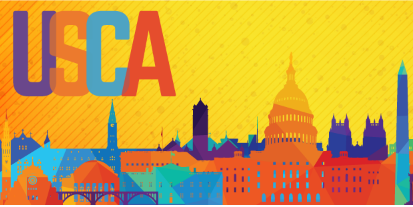Letters from the Director: United States Conference on AIDS (USCA)
This year’s U.S. Conference on AIDS (#2019USCA), organized by the National Minority AIDS Council (NMAC), focused on the Nation’s new initiative Ending the HIV Epidemic: A Plan for America (EHE), and took place in Washington, DC, September 5–8. The conference was a momentous gathering of more than 3,000 attendees who are committed to joining forces to end the epidemic and included: federal leaders; researchers; representatives from health departments, community-based organizations, and health centers; health providers; people with HIV; activists; and donors.
 Prior to the start of the USCA, I was invited to participate in a full-day pre-conference meeting, The Gathering of the 57 (G57) Jurisdictions. The pre-conference meeting included representatives from most of the 57 jurisdictions prioritized in Phase I of EHE and representatives from several U.S. Department of Health and Human Services agencies.
Prior to the start of the USCA, I was invited to participate in a full-day pre-conference meeting, The Gathering of the 57 (G57) Jurisdictions. The pre-conference meeting included representatives from most of the 57 jurisdictions prioritized in Phase I of EHE and representatives from several U.S. Department of Health and Human Services agencies.
The conference offered more than 160 workshops and four plenaries highlighting cutting edge developments in HIV research, prevention, and treatment; and it included dedicated program tracks on the impact of HIV on specific communities.
Additionally, USCA provided a safe forum for activists to contribute to the EHE discussion through a peaceful protest. Protesters conducted a speak-out to share dissenting opinions and concerns about HIV plans and policy with federal leaders; and to ask questions and seek answers. They were focused on working with leaders to ensure that the EHE plan is inclusive and responds to the specific needs of diverse communities, including those disproportionately impacted by HIV.
The goal of the EHE, and the impetus behind the 2019 conference, is to foster a national collaborative effort to reduce the number of new HIV cases by 75 percent in five years and 90 percent by the year 2030, to avert an estimated total of 250,000 new HIV infections over 10 years.
On behalf of the National Institutes of Health (NIH), I attended the USCA to provide input on the key roles that NIH research is contributing to the EHE initiative. The OAR is coordinating harmonized NIH research activities to fill current gaps in the scientific understanding of the HIV epidemic, including comprehensive research efforts to advance HIV prevention tools to help end the epidemic.
In fiscal year 2019, the OAR provided over $11 million to jumpstart EHE projects through the Centers for AIDS Research (an NIH program established by the National Institute of Allergy and Infectious Diseases [NIAID] and co-funded by multiple Institutes/Centers at NIH); the National Institute of Mental Health’s (NIMH) AIDS Research Centers; and the Sexual and Gender Minority Research Office (SGMRO). Also, as the steward of the more than $3 billion NIH HIV/AIDS research budget, OAR manages, oversees and coordinates the public investment to ensure that research dollars are aligned with the areas of highest scientific priority to end the HIV pandemic and to facilitate a maximal return on the public investment.
During the USCA conference, I moderated a panel of distinguished public health colleagues from NIH to discuss Priorities for HIV and HIV-Related Research. The purpose of the panel was to share perspectives and gain new insight for our collaborations on the EHE. The panelists included:
- Carl Dieffenbach, Ph.D., Director, Division of AIDS, NIAID;
- Dianne Rausch, Ph.D., Director, Division of AIDS Research, NIMH;
- Karen L. Parker, Ph.D., M.S.W., Director, SGMRO; and
- Minnjuan Flournoy Floyd, Ph.D., Health Scientist Administrator, Services Research Branch, National Institute on Drug Abuse
Following the panel presentations, we conducted a “Listening Session” to hear perspectives from almost 50 conference attendees on what is working and what needs to change to achieve our EHE goals. Participants shared compelling ideas such as: find new ways to get reluctant health providers on board; consider expanding HIV testing in light of immigration challenges; change the way people with HIV are treated while receiving care; increase inclusivity within communities; change the vocabulary being used; host more listening sessions in communities, learn to speak their language, and employ more professionals from those communities. The Session was energizing and resulted in fresh ideas for collaborating with partners nationwide.
Overall, the USCA underscored that after nearly four decades since HIV was discovered, we are at a pivotal time in history. We have the prevention and treatment tools that we need to theoretically end the HIV epidemic, including: recent scientific breakthroughs in biomedical research that have improved care for people with HIV; pre-exposure prophylaxis (PrEP), highly effective in preventing HIV infection for individuals at high risk and one of the most notable recent advances in controlling the epidemic; and new laboratory and epidemiological techniques to assess the spread of HIV. To bring about a lasting end to the global pandemic, we must continue research efforts to find a safe and effective vaccine that can be used in conjunction with all of the HIV prevention modalities in our tool box.
The opportunity to end the epidemic in America is within our reach, and the NIH remains steadfast in its commitment to working collaboratively with all stakeholders to achieve this goal.
Maureen M. Goodenow, Ph.D.
Associate Director for AIDS Research and
Director, Office of AIDS Research
National Institutes of Health
This page last reviewed on December 10, 2024

